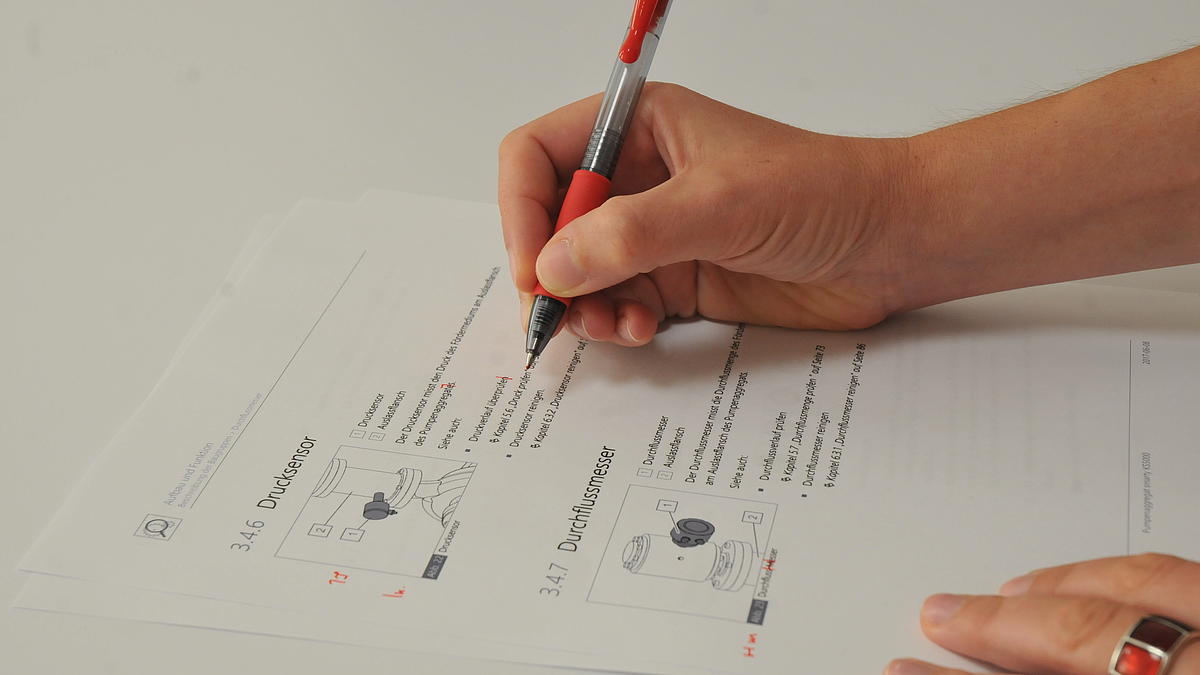A scenario that everyone recognises, and not only in the Technical Editorialdepartment: One reads a text, for example, an operating manual, and stumbles over scrambled letters. Maybe even in the title, as with this Blog. Such mistakes are only human and certainly happen to everyone, although they remain embarrassing. True to the motto "Once Doesn't Count", one skims generously over one or even a few mistakes. However, when these mistakes pile up, they quickly distract from the content. In the worst case, one gives up and puts the text aside. This is especially alarming when the text, in our case the operating manual, contains important information that the reader should consider for his or her own safety, and for the optimal use of the product.
Software can Support the Proofreading, but not Replace it
So that the flow of reading is not hindered by mistakes, comprehensive quality assurance always includes a check for linguistic correctness. There is automatic spell checking, you say? Well, we all know the unintentionally weird examples of strange, nonsensical, or even incorrect "correction" suggestions made by the free-of-charge automatic spelling and grammar checks from the familiar Office programmes. Even very powerful (fee-based) test programmes can neither reliably check all error categories nor evaluate every mistake found in the sense of the author. It remains: Even with good results through tool-based testing, the most reliable tester is still human, namely the experienced editor.
Change the Perspectve Often
In contrast to the software, an editor assists in the correction of different glasses. With a view not only, but especially on the technical documentation, he or she sees through these glasses, for example, mistakes in the following areas:
- The first thing that surely comes to mind: spelling, grammar, and punctuation. The elimination of such mistakes is the classic proofreading that conjures up (perhaps not always fond) memories of school time and red marks in the exercise book. To be absolutely solid in the regulations for these elementary disciplines is a prerequisite when working as an editor.
- In the narrower sense, the following also belong to linguistic error sources: syntax, expression, and style. These areas are a little bit more complex, because there is increasing demand for both language and style assuredness – not something that an official body of rules would contain.
Stylistic requirements also differ according to the type of text. In technical documentation, an important style specification is, for example, the uniform formulation of the various functional units, such as work instructions. Such specifications are typically documented in a Style Guide. The editor must know these guidelines in detail and also have the competence to make a well-founded decision, even if the Style Guide does not make a statement on the issue at hand.
- Proofreading always overlaps with checking for factual correctness: Is the wording sufficiently precise? Are there textual redundancies or even contradictions? Does the text have a well-thought-out structure that supports the absorption of information?
Often, an editor has too little specialist knowledge to be able to verify the text to be checked, by him or herself. However, he or she has sufficient textual competence to be able to identify deficiencies in content such as unclear wording or information that is necessary for understanding but missing, etc. As one of the first readers, the editor can provide constructive criticism and give the author specific suggestions for revision.
- How important it is to have clear and consistent terminology in technical documentation has already been a subject in our Blog several times. In order to prevent errors from creeping in, despite tool-supported terminology management, the editor also checks whether the correct term is used for the correct part – and used in the correct place.
- There is no question that functional design® supports text capture and processing. However, it is also generally accepted that errors can occur when formats are assigned to functional units. The Result: Instead of making it easier for the user to facilitate information, she may not record it at all because she has learned to associate the incorrectly-assigned format with another type of information that she is deliberately not concerning herself with. This is especially the case with texts that serve as references and are often read only as excerpts – operating manuals, for example. During the proofreading, it is also checked whether the formats introduced are being used consistently and correctly.
- Which many may not be equally aware of: An editor doesn't just look at the text. Especially in instructional texts, technical illustrations are often used to support the text. Here, an editor checks the Text-Image Reference: Is the appropriate illustration being referred to? Are the position numbers and captions correct? Are the captions of the images well formulated?
Perhaps you're surprised after reading this listing of how varied the tasks within proofreading are. This has its origin, not least because of the numerous formal requirements that technical documentation must fulfil. The more rules that must be observed, the higher the risk of error – whereby, it is better to speak of "violations" than "mistakes". For what may be desirable in other types of text (for example, the variation in the wording), should not occur in so-called "controlled texts" such as operating manuals.
The Clever Combination of Human and Electronic Performance
Of course, an experienced editor doesn't take these perspectives one after the other. To look at the same text critically several times through different pairs of glasses would be highly inefficient. It is unnecessary for two reasons: On one hand, professional Technical Editorial offices make use of the opportunities offered by special software such as Content Management Systems and terminology tools, not only during checking, but also during content creation. In this way, the frequency of errors can be reduced significantly. On the other hand, experience plays an important role in editing, especially when it comes to the time factor. In order to find all remaining mistakes during the final review (and in as few passes as possible), a high level of familiarity with the layout and the formats and graphic styles used is required – provided, of course, that one is familiar with all applicable rules and regulations, including the editorial guidelines. An experienced proofreader can thus detect mistakes from several categories simultaneously in a single pass.
A Practical Example
The smarty KS500 Pump unit Operating Manual in our smart space (log-in required) demonstrates an example of what a proofread text looks like. No doubt about it: The procedures described in this brief excerpt would certainly be comprehensible, even without a part of the corrections. The aim, however, should be to make it possible to absorb the information quickly, without misunderstandings and irritatingly leafing back and forth, because one must ensure that one's own interpretation is correct. Such an optimised text leaves no questions unanswered in the subsequent translation process.
By the way, the handwritten correction is only one of several approaches. Depending on the editor in which the text was created, it is usually also possible to make corrections in electronic form.
All texts benefit from proofreading, be it technical documentation, a report, a technical article ... For the documents produced by us, proofreading is an integral part of quality control. However, we also offer our proofreading services as an independent service, which you can make use of for your own texts. If you suspect that the Error Gremlin has snuck in, please contact us!

